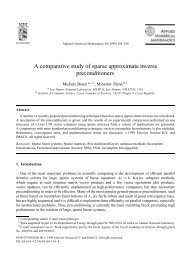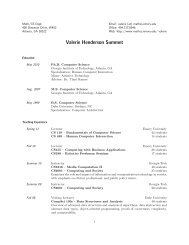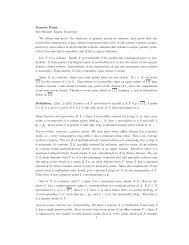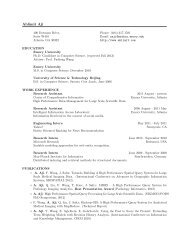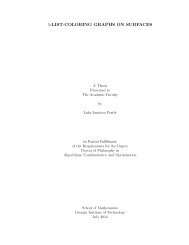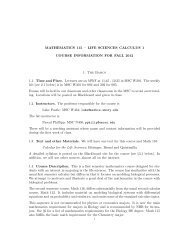Chapter 3 Solution of Linear Systems - Math/CS
Chapter 3 Solution of Linear Systems - Math/CS
Chapter 3 Solution of Linear Systems - Math/CS
Create successful ePaper yourself
Turn your PDF publications into a flip-book with our unique Google optimized e-Paper software.
70 CHAPTER 3. SOLUTION OF LINEAR SYSTEMS<br />
3.5 Matlab Notes<br />
A large amount <strong>of</strong> s<strong>of</strong>tware is available for solving linear systems where the coefficient matrices may<br />
have a variety <strong>of</strong> structures and properties. We restrict our discussion to solving “dense” systems<br />
<strong>of</strong> linear equations. (A “dense” system is one where all the coefficients are considered to be nonzero.<br />
So, the matrix is considered to have no special structure.) Most <strong>of</strong> today’s best s<strong>of</strong>tware for<br />
solving “dense” systems <strong>of</strong> linear equations, including those found in Matlab, was developed in the<br />
LAPACK project.<br />
In this section we describe the main tools (i.e., the backslash operator and the linsolve function)<br />
provided by Matlab for solving dense linear systems <strong>of</strong> equations. Before doing this, though, we<br />
first develop Matlab implementations <strong>of</strong> some <strong>of</strong> the algorithms discussed in this chapter. These<br />
examples build on the brief introduction given in <strong>Chapter</strong> 1, and are designed to introduce some<br />
useful Matlab commands as well as to teach proper Matlab programming techniques.<br />
3.5.1 Diagonal <strong>Linear</strong> <strong>Systems</strong><br />
Consider a simple diagonal linear system<br />
a11x1 = b1<br />
a22x2 = b2<br />
.<br />
⇔<br />
⎡<br />
a11<br />
⎢ 0<br />
⎢<br />
⎣ .<br />
0<br />
a22<br />
.<br />
· · ·<br />
· · ·<br />
. ..<br />
0<br />
0<br />
.<br />
⎤ ⎡<br />
⎥ ⎢<br />
⎥ ⎢<br />
⎥ ⎢<br />
⎦ ⎣<br />
0 0 · · · ann<br />
annxn = bn<br />
If the diagonal entries, aii, are all nonzero, it is trivial to solve for xi:<br />
x1 = b1/a11<br />
x2 = b2/a22<br />
.<br />
xn = bn/ann<br />
x1<br />
x2<br />
.<br />
xn<br />
⎤<br />
⎡<br />
⎥<br />
⎦ =<br />
⎢<br />
⎣<br />
In order to write a Matlab function to solve a diagonal system, we must decide what quantities<br />
should be specified as input, and what quantities should be specified as output. For example, we<br />
could input the matrix A and right hand side vector b, and output the solution <strong>of</strong> Ax = b, as is done<br />
in the following code:<br />
function x = DiagSolve1(A,b)<br />
%<br />
% x = DiagSolve1(A, b);<br />
%<br />
% Solve Ax=b, where A is an n-by-n diagonal matrix.<br />
%<br />
n = length(b);<br />
x = zeros(n,1);<br />
for i = 1:n<br />
if A(i,i) == 0<br />
error(’Input matrix is singular’)<br />
end<br />
x(i) = b(i) / A(i,i);<br />
end<br />
Notice that we make use <strong>of</strong> the Matlab function length to determine the dimension <strong>of</strong> the<br />
linear system, assumed to be the same as the length <strong>of</strong> the right hand side vector, and we use the<br />
b1<br />
b2<br />
.<br />
bn<br />
⎤<br />
⎥<br />
⎦ .



